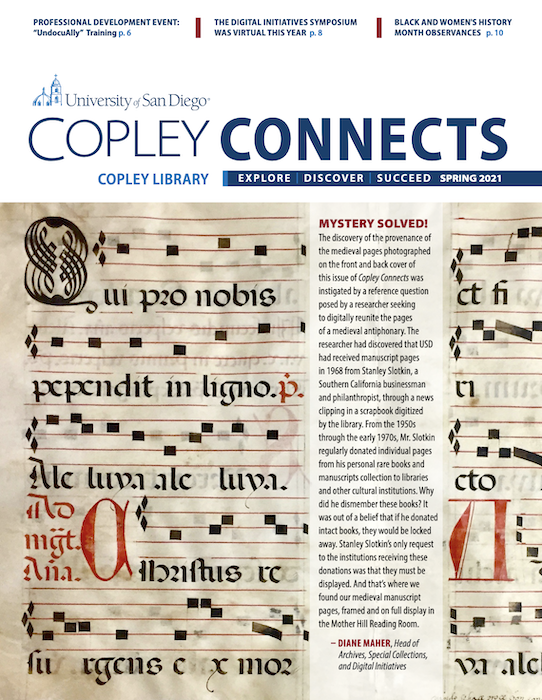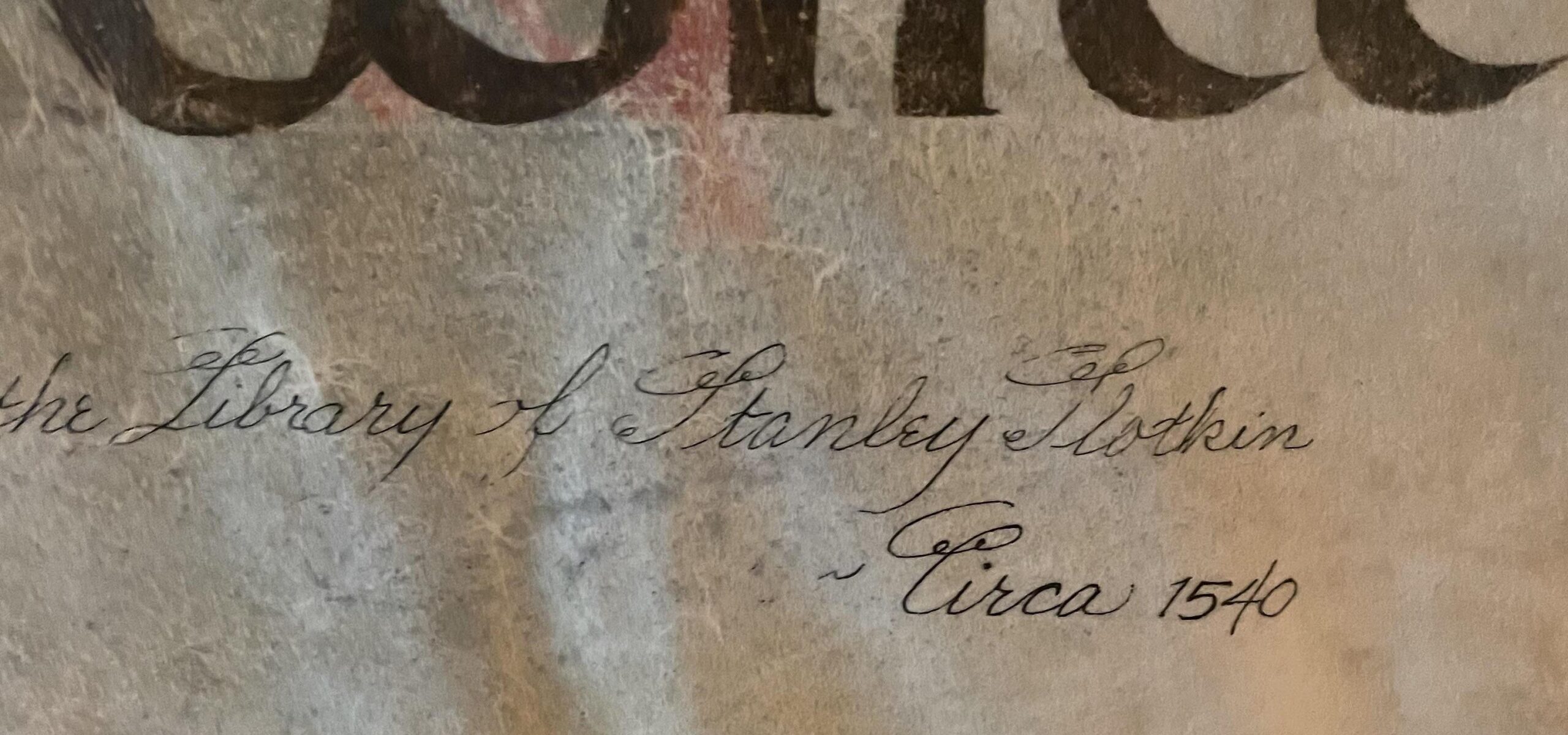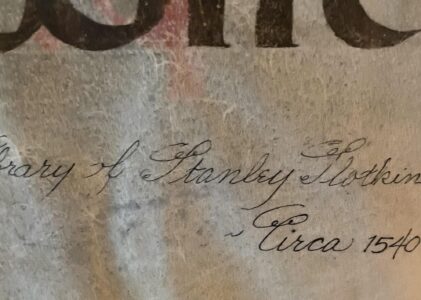In teaching book history courses here at Geneseo, I came across what I thought was a small and relatively straightforward portfolio of antiquarian book leaves which are part of the college library’s Special Collections. My students however quickly realised that the information provided by the library’s catalogue—information originally provided in the 1960s by the donor and creator of the portfolio set, a man called Stanley Slotkin—just didn’t fit with what they found when they tried to research them further.
A careful cross-checking of the leaves has shown that almost all of them were misidentified (I give a corrected list of them below). In the process of trying to untangle the incorrect claims about them, I discovered that the donor, Stanley Slotkin, was something of a colourful character who was active as a biblioclast (or book breaker) from the 1950s through to at least the late 1970s. He broke up a significant number of early printed books and several late medieval/early modern manuscripts and donated them to a variety of institutions across the United States.
I’m now trying to piece together Slotkin’s career as a biblioclast, although it’s proving something of a challenge. He’s got a rollicking obituary in a 1997 issue of the Los Angeles Times, but his activities don’t seem to anything near as well-documented as those of more famous book breakers like Otto Ege.
More Info?
If you know more about Stanley Slotkin, or about the books and manuscripts that he broke, please do get in touch! I’m very curious to know more about his activity as a biblioclast, and whether the other portfolio sets that he produced are similarly misidentified.

The Geneseo Leaves
The leaves here are numbered in accordance with how they appear in the college’s library catalogue.
Leaf One
Text Claimed: Abdullah al-Sharqawi, The margin of Al-Sharqawi on the explanation of Al-Tahrir in Fiqh written by Zakaria Al-Ansari. 1277 AH (1860/1861CE). Provenance in Cairo.
Text Identification: Husayn Kashifi, Anvār-i Suhaylī. Date unknown.
Note: Thank you to my colleague, Dr. Sadegh Ansari, for this identification.
Leaf Two
Text Claimed: Testamenti Veteris Biblia Sacra, sive Libri Canonici Priscae Judaiorum Ecclesiae a Deo Traditi, Latini recens ex Hebreao facti. 1593. Provenance in Vienna.
Text Identification: Testamenti Veteris Biblia Sacra, sive Libri Canonici Priscae Judaiorum Ecclesiae a Deo Traditi, Latini recens ex Hebreao facti. 1593.
Note: This is the lone leaf which is exactly as represented.
Leaf Three
Text Claimed: The Bible: That is, the Holy Scriptures Conteined in the Old and New Testament. 1594. Provenance in Cairo.
Note: Slotkin claims this to be an edition of the Breeches (or Geneva) Bible, but it is an edition of the Bishop’s Bible.
Leaf Four
Text Claimed: Biblia Sacra Vulgatae Editionis Sixti Quinti Pont Max Iussu Recognita atque edita. Venice, 1600.
Text Identification: Biblia Sacra Vulgatae Editionis Sixti V. Pont. Max. Iussu Recognita Atque Edita. Antwerp, 1624.
Leaf Five
Text Claimed: The New Testament of Our Lord Iesus Christ, translated out of Greeke by Theod. Beza. London, 1602.
Text Identification: The text of the New Testament of Iesus Christ, translated out of the vulgar Latine by the Papists of the traiterous seminarie at Rhemes. London, 1601.
Leaf Six
Text Claimed: La sainte Bible contenant l’ancien et le nouveau testament traduite en Francois sur La Vulgate, avec des courtes Notes pour l’intelligence de la Lettre. 1604.
Text Identification: La Sainte Bible contenant l’Ancien et le Nouveau Testament traduite en Français sur la Vulgate avec de courtes Notes pour l’intelligence de la Lettre. 1704.
Note: The date claimed on the facsimile title page cannot be accurate. The translator of this edition, Le Maistre de Saci, was not born until 1614, while Frick/Fricx was only King’s Printer to Charles II 1698-1709.
Leaf Seven
Text Claimed: Rashi’s Commentaries on the Tanakh. 1609. Found in Jerusalem.
Text Identification: Book of Jeremiah, edition unidentified.
Note: Thank you to Rabbi Rachel Barenblat for her assistance in identifying the text.
Leaf Eight
Text Claimed: La S. Bibla quei ei Tut la Soinchia Scartira ner Tuts ils Cudischs d’ilg Vedera Nief Testament cun ils Cudischs Apocryphs. 1618. Purchased in Budapest, 1959.
Text Identification: Ilg Nief Testament da Niess Senger Jesu Christ, mes giu en Rumonsch da la Ligia Grischa: tras Luci Gabriel, Survient d’ilg Plaid da Deus a Lgion. 1717.
Note: Slotkin claims that this text is written in the language of the Roma people (Romani) but it is actually written in Romansh, a language spoken in Switzerland.
Leaf Nine
Text Claimed: Missale Romanum ex Decreto Sancrosancti concilii Tridentini Restitutum, B. Pii V Pontificis Maximi Iussu Editum Clementis VIII ac Urbani VIII Auctortiate Recognitum. 1677. Found in Nazareth.
Text Identification: Missale Romanum ex decreto S. concilii Tridentini restitutum, Sancti Pii V. jussu editum, Clementis VIII. et Urbani VIII. auctoritate recognitum, nunc denuo cum, missis Sanctorum novissime a summis Pontificibus usque ad Pium IX, concessis impressum. 1856.
Leaf Ten
Text Claimed: De Hartmanni Pistoris Opera Omnia Simonis Ulrici Pistoris Studio et additionibus. 1678. Found in Vienna, 1952.
Text Identification: Partitiones iuris canonici seu pontificii in quinque libros digestae: quae instar syntagmatis specialis totius iuris ecclesiastici sunt. 1594.
Leaf Eleven
Text Claimed: Die Catholische Strassburger Bibel oder Heilige Schrift, Alten und Neuen Testaments nach der gemeinen Lateinischen und von der heiligen Kirchen bewehrten. 1701. Found in Nazareth.
Text Identification: Biblische Historie, oder Geschicht-Beschreibung des Alten und Neuen Testaments. 1759.
Leaf Twelve
Text Claimed: The Holy Bible containing the Old Testament and the New: with Annotations wherein the Sacred Text is at large Recited, the Sense Explained, and the Instructive example of the Blessed Jesus and his Holy Apostles, to our Imitation Recommended. 1705. Found in Scotland.


I just found a page of a 1574 Martin Luther Bible in my parents’ storage shed. It was rolled up in a tube and has been there since our family trip to the Holy Lands in 1962. I had no idea what it was until I started googling it! I’d love to know more!
Hi. I own a full set of the pages that Stanley Slotkin mailed to anyone who asked in the 1960’s or 1970’s. My father requested and received a set of pages and facsimile title pages and the cover material including a reprint of a Los Angeles Times story about Mr. Slotkin and a request for $3.50 to defray expenses. The facsimile title pages are notably unattractive. I did laugh at the misidentifications you describe here. I picture Slotkin up to his elbows in pages and pages he could not read, stuffing them into mailing tubes. The tube my father stored was too decayed to save, but all the pages, including many claiming to be from the 1600s, are clean. I have French, Latin, Hebrew, English, and Arabic pages. What should I do with this set? Is it dumpster worthy? I am 70 and downsizing. My father died in August 2023 at the age of 95. He loved books and printing, and would not have approved of book breaking in any way! I miss him. Thanks for this interesting post!